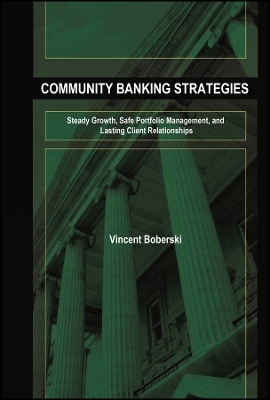
Community Banking Strategies
Bloomberg Press (Verlag)
978-1-57660-369-7 (ISBN)
- Lieferbar (Termin unbekannt)
- Versandkostenfrei
- Auch auf Rechnung
- Artikel merken
With Community Banking Strategies, author Vincent Boberski, a financial professional who has spent years working with senior management and the boards of directors at local banks, skillfully reveals how community banks can compete against bigger institutions in the wake of the most significant financial crisis since the 1930s.
Chapter by chapter, he offers practical advice on many of the most important issues in this area, including portfolio management, balance sheet management, and dealing with interest rate and credit cycles. Along the way, Boberski also offers in-depth insights on establishing and encouraging the lasting client relationships that produce the most essential piece of the banking business: focusing on increasing core deposits, which is at the heart of any good local bank.
* Details the strategies, products, and tactics that will enable community banks to create opportunities out of market dislocations and effectively manage risk
* Reveals how to capture consistently profitable growth at the expense of regional and national competitors
* Discusses what it takes to transform newfound market dynamics into customer relationships that touch both sides of the balance sheet
If you want to gain a better understanding of the strategies that could consistently lead to success in this field, this book is the best place to start.
VINCENT BOBERSKI is a senior vice president and partner at Vining Sparks IBG, a broker/dealer for institutional investors. He was a senior vice president at FTN Financial and a managing director and head of fixed income research and strategies at RBC Capital Markets. Boberski began his career at the Federal Reserve Bank of Richmond. He holds an MBA from the University of Chicago; an undergraduate degree from William & Mary, where he was a Wilson Scholar; and the CFA and PRM designations. Boberski is a regular contributor to CNBC and Bloomberg TV and radio. He speaks frequently at institutional investment conferences and is quoted often in the financial press. He lives in Memphis with his wife Anne, two children, and more dogs than are strictly necessary.
Preface.
Acknowledgments.
1 A New Era for Community Banking.
A Five-Forces Analysis of the Competitive Position of Community Banks.
Rivalry Within the Industry and New (Really Returning) Entrants.
The Bargaining Power of Suppliers and Customers.
The Threat of New Products.
Has the Community Banking Model Changed?
Winners and Losers.
The Revolution of 2008.
The Nationalization of Fannie, Freddie, and Poof! No More Private Securitization.
The Loss of Wall Street Balance Sheets: Who Moved My Primary Dealer?
The Collapse of the Consumer: An Escalade for Every Driveway.
The Collapse of the Housing Market: Jingle Mail, Jingle Mail, Jingle All the Way.
A Look Forward.
Consolidation and Less Competition for Community Banks from Larger Institutions.
Signifi cantly Improved Liability Pricing.
More Big Failures.
A Recession Deeper Than the Early 1980s.
Housing Prices Fail to Rise.
The Securitization Engine Fails to Restart.
The Treasury Effectively Becomes an Activist Shareholder.
Crowding Out by the Treasury.
A Prolonged Period of Stagfl ation Driven by Skyrocketing Energy Costs and Permanently Higher Tax Rates.
Where, Incidentally, Is the Next Bubble Going to Be If Not in Goods Prices?
2 Historical Credit Crises and What's Different Now.
The Derivatives Mess of 1994.
The Russian and LTCM Crisis of 1998.
The Commercial Real Estate and S&L Crisis of 1988 to 1992.
How Bad Can Things Get?
3 Valuations and Lessons from the Equity Markets.
What Drives Bank Valuations?
What Investors Look for in Different Parts of the Credit Cycle.
Practical Implications.
4 Liabilities and Capital.
Liabilities and Franchise Value.
Advice from a Flat Curve Environment (2007).
What Works.
5 Managing the Balance Sheet Through Different Interest-Rate Cycles.
What Brokers Will Ask You to Do and When You Should Do Them.
Wholesale Leverage.
Deleveraging, Including Loan Sales.
Bond-Portfolio Restructuring.
Pre-Refunding.
Summary 72
6 Investments and the Wholesale Balance Sheet.
The Cost of Liquidity.
The Bond Portfolio and A/L Management.
The Portfolio as an Earnings Driver.
Appropriate Products for Bank Investment Portfolios.
Agency MBS and CMOs.
Ginnie Mae MBS and CMOs.
SBA Floating- and Fixed-Rate Pools.
Callable and Bullet Agency Debentures.
Bank-Qualifi ed Municipals.
Portfolio Structures and Processes That Work.
7 What Banks Should Ask of Their Brokers.
Products and Services Your Broker Should Provide.
Different Brokerage Models.
Questions Your Broker Should Know the Answer to (or Should at Least Ask).
Summary.
8 Tax Effi ciency: As Important as Operational Efficiency.
When Munis Make Sense.
When to Put BOLI on the Balance Sheet.
Case Study: Munis Versus BOLI.
BOLI Specifics: The Case for Separate Account Versus General Account.
Summary.
9 Derivatives as a Way to Manage Balance Sheet, Earnings, and Business Risk.
Macro, One-Way, and Two-Way (or Client) Hedging Examples.
Macro Hedge.
One-Way Hedging.
Two-Way or Client Hedging.
Summary.
A Word on Structured Repo.
Appendix: Caps, Floors, and Swap Valuations.
Afterword.
Appendix.
Performance Measurement Through Peer Analysis and Benchmarking.
Synthetic Duration Matching.
Synthetic Historical Volatility Matching.
SD of Portfolio Returns ÷ SD of Index Return.
Sharpe Ratio, Treynor Measure, Scaled Returns, and Scenario Analysis.
About the Author.
Index.
| Erscheint lt. Verlag | 21.9.2010 |
|---|---|
| Reihe/Serie | Bloomberg Financial |
| Verlagsort | Princeton |
| Sprache | englisch |
| Maße | 161 x 236 mm |
| Gewicht | 363 g |
| Themenwelt | Wirtschaft ► Betriebswirtschaft / Management ► Finanzierung |
| Betriebswirtschaft / Management ► Spezielle Betriebswirtschaftslehre ► Bankbetriebslehre | |
| Wirtschaft ► Betriebswirtschaft / Management ► Unternehmensführung / Management | |
| ISBN-10 | 1-57660-369-5 / 1576603695 |
| ISBN-13 | 978-1-57660-369-7 / 9781576603697 |
| Zustand | Neuware |
| Haben Sie eine Frage zum Produkt? |
aus dem Bereich


